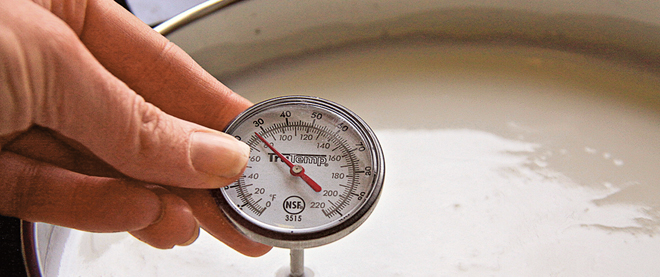How to find your whey in the kitchen
The art and science of making your own cheese is within reach of the average cook
Share

Ella Kinloch passes me a large lump of steaming cheese curd and instructs me to start kneading. It’s seriously hot—straight out of the pot of simmering whey—and I toss it like a hot potato, my hands turning as red as boiled lobsters as I quickly twist and fold the gooey white mass. First it breaks apart like a ball of soft clay but soon it’s stretching more like Plasticine. And then it happens. “Yes, you have mozzarella,” says Kinloch, grinning. From this handful of coagulated milk, I have created my very own almost perfect, nearly shiny, ball of fresh mozzarella.
Kinloch is an amateur cheese maker. She has no dairy, no commercial cheese-making facility, no aging room. But she’s studied cheese making, apprenticed with an expert from New Jersey, took courses in Vermont and British Columbia, and, with her new Calgary-based business Make Cheese, she’s teaching foodies about making cheese at home and offering her Lotsa Motsa kits online. She’ll even come to your house for a cheese-making party.
“The cheese nights really work. There’s something about making cheese, people are just fascinated by the process,” says Kinloch, who started selling her mozzarella-making kits online before Christmas. She was staggered when 500 flew out the door in December alone. She’s since created a kit for brie and plans to add blue, Gouda and cream cheese.
It’s just another example of the growing artisanal food movement where people are learning old-world skills of making traditional breads, curing bacon and sausages, fermenting wine and beer, and now making yogourt and cheese. Epicurious.com recently extolled the virtues of making yogourt at home, a product that’s free of fillers, stabilizers and flavouring, while specialty shops like New York’s Culture sell fresh and frozen yogourt made on site daily.
It takes little more than a scoop of natural yogourt or kefir to get a glass jar of milk fermenting on the counter, and basic ricotta is easily made with milk and lemon juice. Add a specific culture, and you’re on the way to making any cheese you choose.
You get about a half kilo of cheese from four litres of milk, so it’s not only tasty and natural, it’s also a bargain. When I made my first batch of fresh ricotta I started with goat milk from Alberta’s Fairwinds Farm, heated it up with a little buttermilk and lemon juice, and almost instantly had sweet, delicate curds. After just an hour draining in a cheesecloth-lined sieve in the refrigerator, it was a soft but solid cheese that I served with blueberries for breakfast, and cut into cubes to drizzle with olive oil and sea salt for snacks.
It’s easy to find cheese and yogourt recipes online, and companies like Ontario’s Glengarry Cheesemaking and Dairy Supply sell professional moulds, cultures and cheese-making supplies. How-to expert Ashley English has recently published Home Dairy: All You Need to Know to Make Cheese, Yogurt, Butter and More, one of the titles in her Homemade Living series.
But what I’m learning from Ella Kinloch is that making fresh mozzarella, like any cheese, is part art and part science, so it’s nice to have a hands-on coach. After you cut the curd (when most cheeses are simply scooped into moulds to drain), you need to know how to knead, stretch and form the balls of cheese.
We’ve been standing in Kinloch’s kitchen for about an hour while she simmers a big pot of homogenized milk and inoculates it with citric acid and rennet. After the fat curds are scooped from the simmering whey, she dips a large spoonful back into the liquid, reheating the curd to ready it for stretching. That’s the art part. Too much handling and you end up with rubbery balls. A good fresh mozzarella should be smooth, shiny but barely firm. The science part requires a sterile work environment and the proper cultures and temperatures.
But making fresh cheese is a simple and surprisingly quick process. And once you feel that curd magically turn from a jiggly mass to a delicate round of cheese in your hands, it’s addictive.